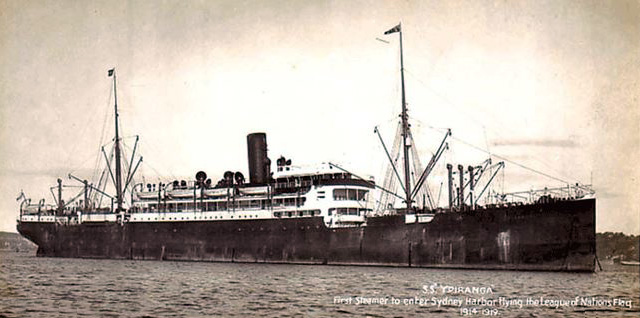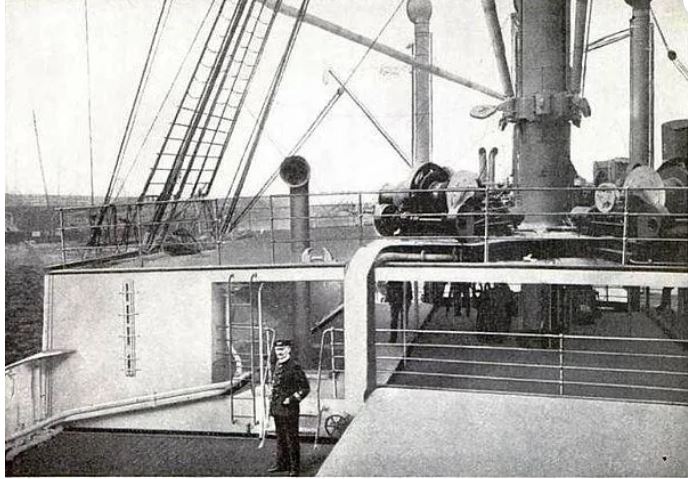Difference between revisions of "HMT Ypiranga"
From Our Contribution
(→England to Melbourne 15 November 1919 - 26 December 1919) |
|||
| (5 intermediate revisions by the same user not shown) | |||
| Line 1: | Line 1: | ||
| − | {{Infobox | + | {{Infobox ship |
| − | | | + | | image = [[File:SS_Ypiranga.jpg]] |
| − | |||
| − | |||
| − | |||
| − | |||
| − | |||
| − | |||
| caption = | | caption = | ||
| − | | | + | | image2 = [[File:SS_Ypiranga_1.jpg]] |
| − | | caption2 = | + | | caption2 = Stabilising water tanks |
| + | | shipname = HMT Ypiranga | ||
| + | | shipowner = Hamburg-America Line (Hapag-Lloyd) | ||
| + | | shipbuilder = Friedrich Krupp Germaniawerft, Kiel, Germany | ||
| + | | shipyardnumber = 134 | ||
| + | | shiplaunched = 3 May 1908 | ||
| + | | shipcompleted = 14 Oct 1908 | ||
| + | | shipinservice = 14 Oct 1908 | ||
| + | | shipoutofservice = 1950 | ||
| + | | shipinservice2 = | ||
| + | | shipoutofservice2 = | ||
| + | | shipreclassified = | ||
| + | | shipID = | ||
| + | | shipfate = ran aground (wrecked) 1950 | ||
| + | | shiptype = passenger / cargo ship | ||
| + | | shiptonnage = 8,142 tons | ||
| + | | shiplength = 448.4 ft (136.65m) | ||
| + | | shipbeam = 55.3 ft (16.84m) | ||
| + | | shipdepth = 29.8 ft (9.07m) | ||
| + | | shippropulsion = Twin Screw | ||
| + | | shipspeed = 14 knots (25.93 km/h) | ||
| + | | shipcapacity = 136 crew & 1,311 passengers | ||
| + | }} | ||
| − | |||
| − | |||
| − | |||
| − | + | ==Remarks== | |
| − | + | ''S.S. Ypiranga'' was a German-registered cargo-steamer owned and operated by Hamburg-America Line shipping company. After launch ''Ypiranga'' was found to be notoriously unsteady at sea. This was remedied by installing two water tanks near the fore and after masts on the upper deck, connected by a flying bridge. The flow of water between the tanks, controlled by regulating the movement of the air in the side branches, served to steady the ship in rough water, and it gained the reputation of being particularly steady after installation. On April 15th, 1912, ''Ypiranga'' was one of the many ships in contact with the ''RMS Titanic'' as Titanic was sinking. She spent the war years laid up in Germany. | |
| − | |||
| − | |||
| − | |||
| − | |||
| − | |||
| − | |||
| − | |||
| − | |||
| − | |||
| − | + | ''Ypiranga'' served until 1919, when it was ceeded to the United Kingdom as a war reparation and placed under management of the White Star Line, before an ownership change wich saw it renamed ''Assyria'', used on the London/Bombay run. She was the first ship to enter Sydney Harbour flying the flag of the League of Nations. Sold in 1929 to a Portuguese company, Companhia Colonial de Navegação which renamed her ''Colonial'' for ue on their Lisbon - East Africa routes. | |
| − | |||
| − | |||
| − | |||
| − | |||
| − | |||
| − | |||
| − | |||
| − | |||
| − | |||
| − | In 1950 there were plans to scrap the ship, but during the trip to the scrapyard under tow she broke free of her tug and wrecked near Campbeltown. | + | In 1950 there were plans to scrap the ship, but during the trip to the scrapyard under tow she broke free of her tug and was wrecked near Campbeltown, Scotland. |
==Soldiers carried== | ==Soldiers carried== | ||
| − | == Sydney to England 12 August - 12 October 1919== | + | === Sydney to England 12 August - 12 October 1919=== |
| − | *[[William Wright Casterton MM]] | + | * [[William Wright Casterton MM]] |
| − | ==England to Melbourne 15 November 1919 - 26 December 1919== | + | ===England to Melbourne 15 November 1919 - 26 December 1919=== |
| − | *[[Sidney Herrick Carter]] | + | * [[Sidney Herrick Carter]] |
| − | *[[James Francis Ottaway]] | + | * [[James Francis Ottaway]] |
| − | *[[William George Rosekelly]] | + | * [[William George Rosekelly]] |
[[Category:Ships]] | [[Category:Ships]] | ||
Latest revision as of 17:59, 11 October 2023
Contents
Remarks
S.S. Ypiranga was a German-registered cargo-steamer owned and operated by Hamburg-America Line shipping company. After launch Ypiranga was found to be notoriously unsteady at sea. This was remedied by installing two water tanks near the fore and after masts on the upper deck, connected by a flying bridge. The flow of water between the tanks, controlled by regulating the movement of the air in the side branches, served to steady the ship in rough water, and it gained the reputation of being particularly steady after installation. On April 15th, 1912, Ypiranga was one of the many ships in contact with the RMS Titanic as Titanic was sinking. She spent the war years laid up in Germany.
Ypiranga served until 1919, when it was ceeded to the United Kingdom as a war reparation and placed under management of the White Star Line, before an ownership change wich saw it renamed Assyria, used on the London/Bombay run. She was the first ship to enter Sydney Harbour flying the flag of the League of Nations. Sold in 1929 to a Portuguese company, Companhia Colonial de Navegação which renamed her Colonial for ue on their Lisbon - East Africa routes.
In 1950 there were plans to scrap the ship, but during the trip to the scrapyard under tow she broke free of her tug and was wrecked near Campbeltown, Scotland.

